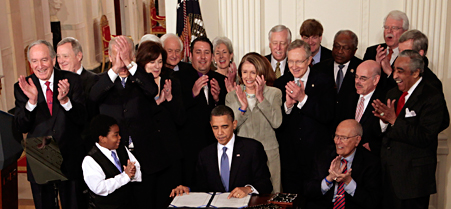Feds to rely on technology to make health reform law a reality
Web sites will provide the public and small businesses ways to compare insurance plans, analyze risks for heart disease and diabetes, and access to counselors to discuss weight control and stress reduction.
 032310healthbillNGins
(Mar. 23) -
President Obama signs the Patient Protection and Affordable Care Act into law on Tuesday.
032310healthbillNGins
(Mar. 23) -
President Obama signs the Patient Protection and Affordable Care Act into law on Tuesday.
The historic health care reform bill President Obama signed into law on Tuesday calls for development of states' health care exchanges that eventually will allow Americans to compare insurance through Web portals as easily as they price and book airline tickets.
The exchanges, as the president outlined in a June 2, 2009, letter to the late Sen. Edward Kennedy, D-Mass., a decades-long champion of universal health care, will create a "market where Americans can one-stop shop for a health care plan, compare benefits and prices, and choose the plan that's best for them."
The exchanges, which will provide coverage to individuals and small businesses not covered by plans offered by larger employers or the federal government's Medicare program for the elderly, will become fully operational in 2014. But language in the 906-page Patient Protection and Affordable Care Act directs the Health and Human Services Department to consult with states to set up by a Web site no later than July 1 that will allow the public to search for the most affordable health coverage.
HHS is required to develop a template for portals that states can use by 2014. By that time, states must establish their own health insurance portal sites that individuals can use to compare health insurance policies that states have certified as qualified health care plans. The exchanges also will serve as a guide for Medicare and Medicaid coverage for eligible individuals.
The law also mandates that HHS develop a rating system for health plans using quality and price as the criteria, and post the information on the state health portals.
States can choose to have their exchanges managed by a government body or by a nonprofit organization that they form. In addition, states can set up two exchanges in 2014, one that serves individuals and another that small businesses use, or they can form one exchange to serve both groups.
To help individuals better manage their health care, the law requires the Centers for Disease Control and Prevention to create a Web site that the public can access to learn more about their personal risks to developing leading diseases such as certain heart ailments and cancer. The sites will provide information on how to prevent the diseases.
HHS also will oversee the development of wellness and prevention programs that the public can access by logging on to a Web site, or by calling or sitting down face to face with a counselor to discuss how to control weight, reduce stress, stop smoking and manage their diets to avoid diabetes.
A universal health care plan will require the government to develop a master patient index that would track the medical and insurance records for every American. The health care reform law does not call for the government to create patient identifiers, but it does make clear that Social Security numbers cannot be used to identify individuals. The law requires HHS to develop unique identifiers for health plans by Oct. 1, 2012.
To prevent waste and fraud, the law suggests states use data-matching technology similar to those applications that hedge funds, investment houses and banks rely on to analyze claims for signs that indicate fraud.
NEXT STORY: New Deputy Director at HHS






